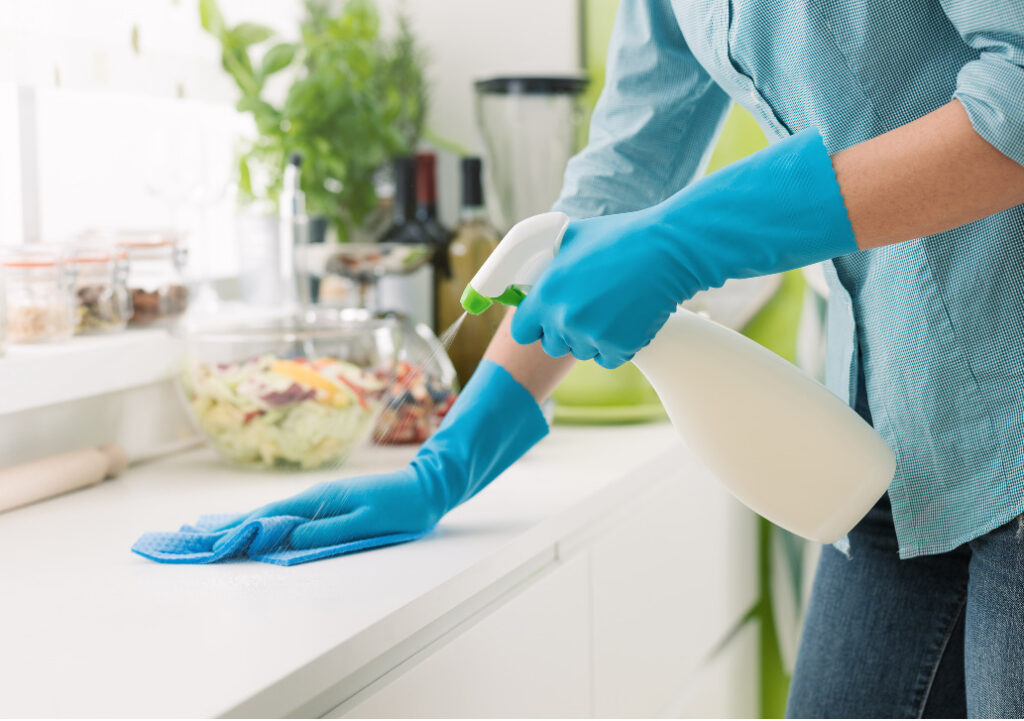When you’re ready to sit down to a nice chicken dinner with your family it’s nice to know that you have your dishes ready to be washed in the dishwasher, and that you’ve wiped down all the counters. The kitchen looks clean.
You’re done, right? Not if you want to prevent viruses, bacteria, and molds from taking hold.
Whenever you cook poultry or raw meat you want to make sure to clean and then sanitize both counter surfaces and the kitchen sink. Rinsing or wiping these areas is not enough to kill the bacteria and germs that have gotten all over your kitchen while you were getting dinner ready.
First, What is Cleaning? Cleaning removes dirt. We clean with soap because it adheres to the molicules and breaks down the grime and dirt so it can be removed.
What is Sanitizing? Sanitizing is killing biohazards in your kitchen. Cleaning removes the environment bacteria and viruses grow in. Sanitizing removes the bio organisms that make us sick.
Here is the BEST way to make sure that your kitchen will be spotless and the germs you can’t see will be eliminated.

- Cleaning comes FIRST
Cleaning is the important first step in making sure that you are getting rid of bacteria that causes foodborne illnesses in your kitchen. When cleaning your surfaces and kitchen sink use warm, soapy water to start. Use a single-use paper towel, dish cloth or dish towel to wipe them clean. If you decide to use a dish cloth or dish towel wash them in the hot water cycle in your washing machine frequently.
Start with a clean dish cloth and dish towel each morning and drop them in the laundry each night, limiting the spread of germs and bacteria. And make sure to wash your hands with anti-bacterial hand soap and hot water to keep your hands clean as well.
What exactly does cleaning do? It is the first step in getting rid of bacteria from the surfaces in your home. Any foodborne illness-causing bacteria can linger on your surfaces for quite a long time. Salmonella lasts for up to 32 hours, and Campylobacter is able to survive on surfaces for up to 4 hours. Both of these are found in raw poultry. Making sure to clean with warm soapy water helps remove dirt, grime, and some bacteria from the surfaces in your kitchen, but it does not kill the bacteria.
- Sanitizing comes NEXT
The next step is to sanitize which removes the bacteria from your kitchen surfaces. Doing this kills any bacteria that may remain. There are many different sanitizers that you can use. One of the easiest is to take 1 tablespoon of bleach per gallon of water, or you can also use a store-bought sanitizer or sanitizer wipe.
Spray or pour your sanitizing solution on whichever surface needs to be cleaned, then wipe it up with a clean paper towel. Make sure that everything is completely dry before using those surfaces or your sink. If you use a store-bought sanitizer make sure to follow the manufacturer’s instructions found on the label. Some store-bought sanitizers have to be rinsed off after you use them.
What exactly does sanitizing do? When you include a sanitizing step in your daily cleaning routine it reduces the number of foodborne illnesses that will survive in your kitchen. Sanitizing kills bacteria! It’s nice to know that sanitizing is the most effective AFTER you have cleaned your kitchen surfaces. So please, don’t skip the cleaning step.
One thing that you have at home that does a very effective job of sanitizing and cleaning is your dishwasher. It cleans your utensils and cutting boards, if they are made of non-porous materials (e.g. solid wood, acrylic, glass, and plastic) and are dishwasher safe. But, if you don’t want to, or can put them in the dishwasher make sure to wash them first with warm soapy water, then use a sanitizing solution to ensure that they also get the clean and sanitizing steps.

Is Cleaning With Sanitizer Enough to Kill Viruses and Bacteria?
Pour the sanitizing solutions on the items and then let them stand for several minutes or you can soak your utensils. Then rinse them and pat them dry with a paper towel. By following these cleaning and sanitizing steps, you will be able to avoid remove any foodborne illness bacteria that you have in your kitchen.
But, the real question is, ‘Is your kitchen safe from viruses and bacteria?” The answer is no. You have only sanitized the surfaces you have touched. You have not sanitized everything.
You have not sanitized the viruses and pathogens in the air, on fabrics, grout, porous surfaces, plants, or in cracks and crevices!

